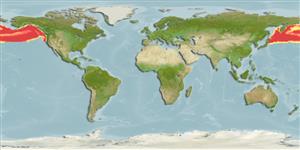>
Lophiiformes (Anglerfishes) >
Oneirodidae (Dreamers)
Etymology: Oneirodes: Greek, 'oneiros' = a dream or dreamlike or out of a dream (suggesting this fish is so strange and marvelous that can exist only in dreams) (Ref. 86949).
Environment: milieu / climate zone / depth range / distribution range
Ecologie
marien bathypelagisch; diepte 200 - 2000 m (Ref. 50550), usually 600 - 850 m (Ref. 86949). Deep-water; 66°N - 30°N, 142°E - 117°W
North Pacific: Okhotsk and Bering seas and off British Columbia, Canada (Ref. 11980).
Grootte / Gewicht / Leeftijd
Maturity: Lm ? range ? - ? cm
Max length : 23.0 cm TL mannelijk / geslacht onbekend; (Ref. 56582); common length : 14.8 cm TL mannelijk / geslacht onbekend; (Ref. 56582); max. gepubliceerd gewicht: 450.00 g (Ref. 56582)
Korte beschrijving
Determinatiesleutels | Morfologie | Morfometrie
Dorsale stekels (totaal) : 0; Dorsale zachte stralen (totaal) : 6 - 7; Anale stekels: 0; Anale zachte stralen: 4; Wervels: 19. Escal bulb bearing an anterior appendage with numerous long filaments at its distal end, a pair of medial appendages with highly branched filaments, a short round papilla and posterior appendages with 2 short filaments (Ref. 559).
Characterized by having similar characteristics like that of O.eschrichtii and O.anisacanthus; posterior margin of the upper part of subopercle is indented to deeply notched; length of ventral fork of opercle 28.6-35% SL; ratio of lengths of dorsal and ventral forks of opercle 0.55-0.60; absence of epibranchial teeth; presence of teeth on pharyngobranchial II; upper jaw teeth 23-39; lower jaw teeth 24-40; teeth on vomer 4-8; dorsal fin rays 6-7; anal fin rays 4; pectoral fin rays 15-18; head length 37.6-49.1% SL; head depth 39.1-50.8% SL; length of premaxilla 29.1-38.6% SL; lower jaw length 44.1-56.1% SL; illicial length 23.1-38.6% SL (Ref. 86949).
Levenscyclus en paargedrag
Maturities | Voortplanting | Spawnings | Egg(s) | Fecundities | Larven
Masuda, H., K. Amaoka, C. Araga, T. Uyeno and T. Yoshino, 1984. The fishes of the Japanese Archipelago. Vol. 1. Tokai University Press, Tokyo, Japan. 437 p. (text). (Ref. 559)
Status op de Rode Lijst van het IUCN (Ref. 130435)
Gevaar voor de mens
Harmless
Gebruik door de mens
Tools
Speciale rapporten
Download XML
Internetbronnen
Estimates based on models
Preferred temperature (Ref.
123201): 1.6 - 3.7, mean 2.3 °C (based on 51 cells).
Fylogenetische diversiteitsindex (Ref.
82804): PD
50 = 0.5000 [Uniqueness, from 0.5 = low to 2.0 = high].
Bayesian length-weight: a=0.01995 (0.00906 - 0.04395), b=3.01 (2.83 - 3.19), in cm total length, based on all LWR estimates for this body shape (Ref.
93245).
Trofisch niveau (Ref.
69278): 4.5 ±0.80 se; based on food items.
Weerstandsvermogen (Ref.
120179): Gemiddeld, minimale populatieverdubbelingstijd 1,4-4,4 jaar (Preliminary K or Fecundity.).
Fishing Vulnerability (Ref.
59153): Low vulnerability (13 of 100).
